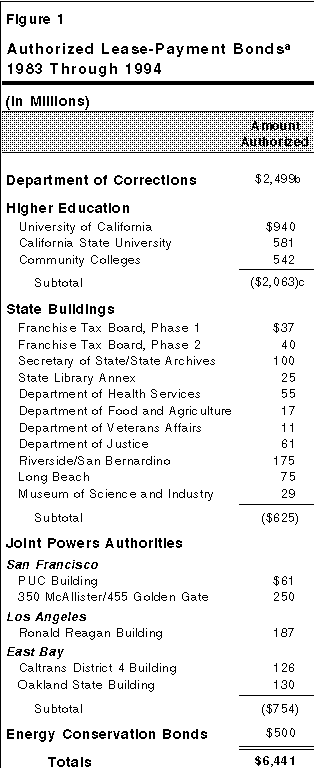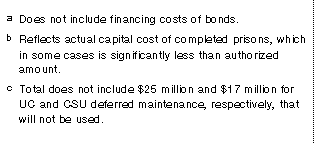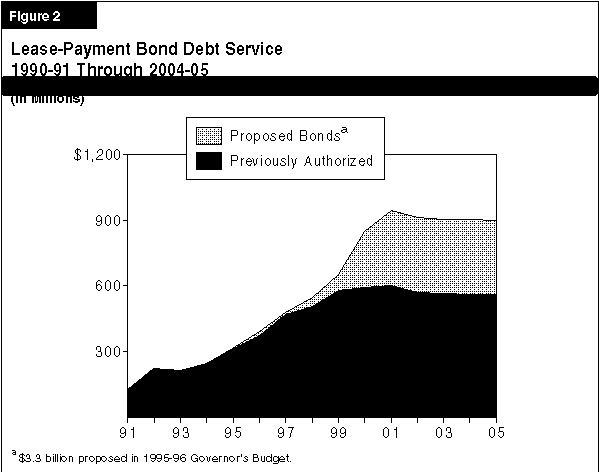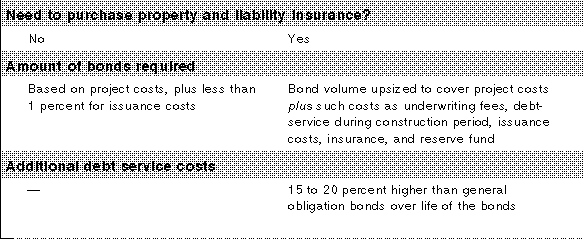

The Legislature has authorized $6.4 billion in lease-payment bonds since 1983 and the Governor's Budget proposes $3.3 billion in new authorizations for 1995-96. Annual debt service costs on lease-payment bonds have increased by almost $200 million over the last three years. For several reasons, total debt service costs for lease- payment bonds are significantly higher than general obligation bonds. We therefore recommend that the Legislature (1) minimize the use of lease-payment bonds in the future and (2) establish a multiyear plan to address its highest priority capital outlay needs using less costly financing alternatives--either direct appropriations or general obligation bonds. We also recommend a course of action for the budget year.
"Lease-revenue" bonds were first authorized by the Legislature in 1983-84. Unlike true revenue bonds, which are used to finance revenue-producing projects such as toll bridges, the state has used lease-revenue bonds to finance projects that do not generate revenue which can pay off the bonds. Instead, the annual debt service payments on these bonds is made from "lease" payments, which are appropriations (usually from the General Fund) to the state agency using the facilities constructed with the bonds. We therefore refer to these bonds as lease-payment bonds.
To date, the Legislature has authorized $6.4 billion in lease- payment bonds for (1) prisons, higher education facilities, and state building projects, (2) state office buildings developed by state/local joint powers authorities, and (3) energy conservation projects in existing state facilities. The authorizations are outlined in Figure 1.


In addition to the amounts previously authorized, the Governor's Budget proposes $3.3 billion in new authorizations-- $525 million in the Budget Bill for various departments (mainly higher education) and $2.7 billion to be proposed in legislation other than the Budget Bill, including:
At the time this Status Check was written, the following legislation had been introduced: (1) SB 1679, Costa (six prisons and the Youth Authority beds), (2) SB 482, Calderon (Department of Corrections headquarters building), (3) SB 565, Johnston (Franchise Tax Board Phase 3 building), (4) SB 1277, Killea (San Diego office consolidation), and (5) AB 1771, Bowler (Teale Data Center).
The budget proposal would continue a recent trend of increased reliance on lease- payment bonds to finance state capital outlay programs. Annual lease-payment bond authorizations for state capital outlay have exceeded appropriations of general obligation bonds each year since 1989-90. From 1989-90 through 1994-95, $4.1 billion in lease- payment bonds have been authorized while $2.1 billion in general obligation bonds have been appropriated.
About $5.7 billion of the $6.4 billion in authorized lease- payment bonds have been sold to date. As more bonds have been sold over time, the annual debt service--the "lease-payments"--for principal and interest also have increased. As shown in Figure 2, debt service has grown from $125 million in 1991-92 to about $310 million in the current fiscal year. As more of the projects funded with these bonds are completed, we estimate that the debt service will increase to $600 million in 2000-01.

Figure 2 also shows that if the $3.3 billion in new authorizations proposed by the Governor are approved, lease-payment debt service would increase to $950 million by 2000-01. This debt combined with debt service costs for currently approved general obligation bonds would result in a total debt service cost of about $2.8 billion in 2000-01.
Figure 3 lists the major differences between lease- payment bonds and general obligation bonds. As shown at the bottom of Figure 3, we estimate that total debt service on lease- payment bonds is 15 to 20 percent higher than for general obligation bonds. (Adjusted for inflation, this difference is about 7 to 10 percent.) Thus, for every $1 billion in capital projects financed with lease-payment bonds instead of general obligation bonds (25-year maturity), the state pays around $275 million to $370 million more in General Fund debt service costs over the life of the bonds.


There are three principal reasons why lease-payment bonds are more costly:
Upsizing of Bonds. The major factor is the need to upsize lease- payment bonds to cover noncapital outlay costs associated with this type of financing. The result of this upsizing is that, compared to general obligation bonds, the state must sell more lease-payment bonds to pay for these noncapital outlay costs. The additional bonds that must be sold under lease-payment financing include amounts sufficient for:
Because of these factors, lease-payment bonds sold over the last two calendar years have totaled, on average, about 16 percent more than the actual costs of the bond-funded projects.
Higher Interest Rates. General obligation bonds are backed by the full faith and credit of the state. Consequently, these bonds are rated higher by the bond-rating agencies than lease-payment bonds. For example, recent general obligation bonds have been sold with an "A" rating from Standard and Poors, while recent lease-payment bond sales have carried an "A-" rating. The rating differential is one reason why lease-payment bonds typically sell at higher interest rates than general obligation bonds and are therefore more costly.
A direct comparison of interest rates is not possible because bonds are sold at different times and are affected by various market conditions at the time of the sale. Our review indicates, however, that lease-payment bonds sell at interest rates that are, on average, about 0.4 percent higher than general obligation bonds. This interest rate differential accounts for about 3 percent of the higher debt service cost for lease-payment bonds compared to general obligation bonds.
Other Costs. In addition to the higher debt service costs, annual administrative costs associated with lease-payment bonds are higher than for general obligation bonds. Furthermore, property and liability insurance must be purchased for projects funded with lease-payment bonds.
As discussed in our Analysis of the 1995-96 Budget Bill (Addressing State Capital Outlay Needs, page I- 13), state departments (excluding transportation programs) have identified five-year capital outlay needs totaling $25 billion. The state, however, also has a relatively high debt burden (5.2 percent of General Fund revenues), and less than $500 million in previously authorized general obligation bonds available to finance the identified capital outlay "need." Additional authorizations of more expensive lease-payment bonds will increase debt service costs beyond what they otherwise would be if the state instead relied on general obligation bonds.
To minimize future debt service costs, the Legislature should minimize future authorizations of lease-payment bonds when addressing the state's capital outlay needs. Given the situation described above, we recommend that the Legislature undertake a comprehensive review of the state's capital outlay needs, set priorities, and establish a financing plan to fund these priorities over a multiyear period. With such a plan in hand, we believe the state could prudently authorize and issue more debt and fund the state's capital outlay needs in the most cost-effective manner--through either direct pay- as-you-go appropriations or general obligation bonds. Effective implementation of a comprehensive multiyear plan might also increase the confidence of voters that any general obligation bond measures placed on the ballot are intended to address the state's highest priority capital outlay needs as identified through the Legislature's planning process.
Budget-Year Proposals. With respect to the $3.3 billion in new lease- payment bond authorizations proposed for 1995-96, we recommend that the Legislature assess whether the projects proposed to be funded with these bonds are so critical that they must proceed this year. For example, based on the most recent inmate population projections and absent any measures that would significantly change population growth, the Department of Corrections will need funding authorization this year for four new prisons as well as emergency housing.
We believe that initial funding for certain other projects could be made with direct appropriations in lieu of lease-payment bonds. In our Analysis of the 1995-96 Budget Bill, we have recommended funding from the General Fund for the planning and design of projects proposed for the Office of Emergency Services and the Department of Forestry and Fire Protection. Finally, the Legislature could defer projects that are not critical for the budget year and consider including them in any general obligation bond package for the 1996 ballots. The proposals for state office buildings, Youth Authority beds, and some higher education projects would fall into this category.